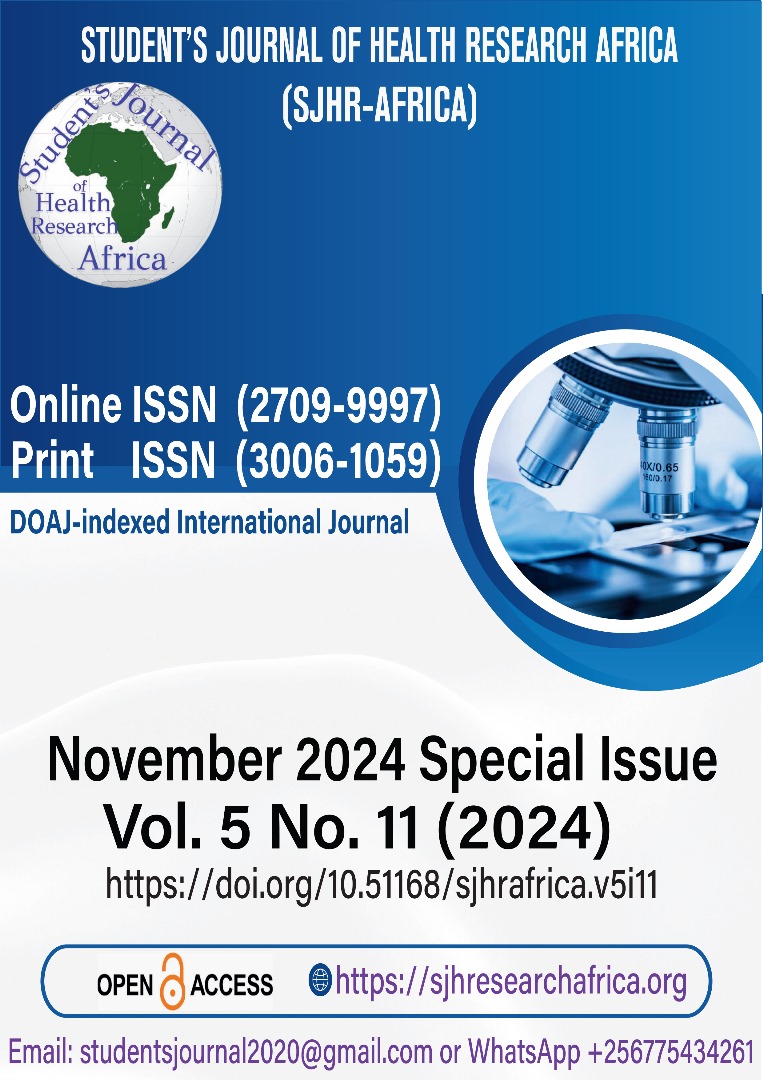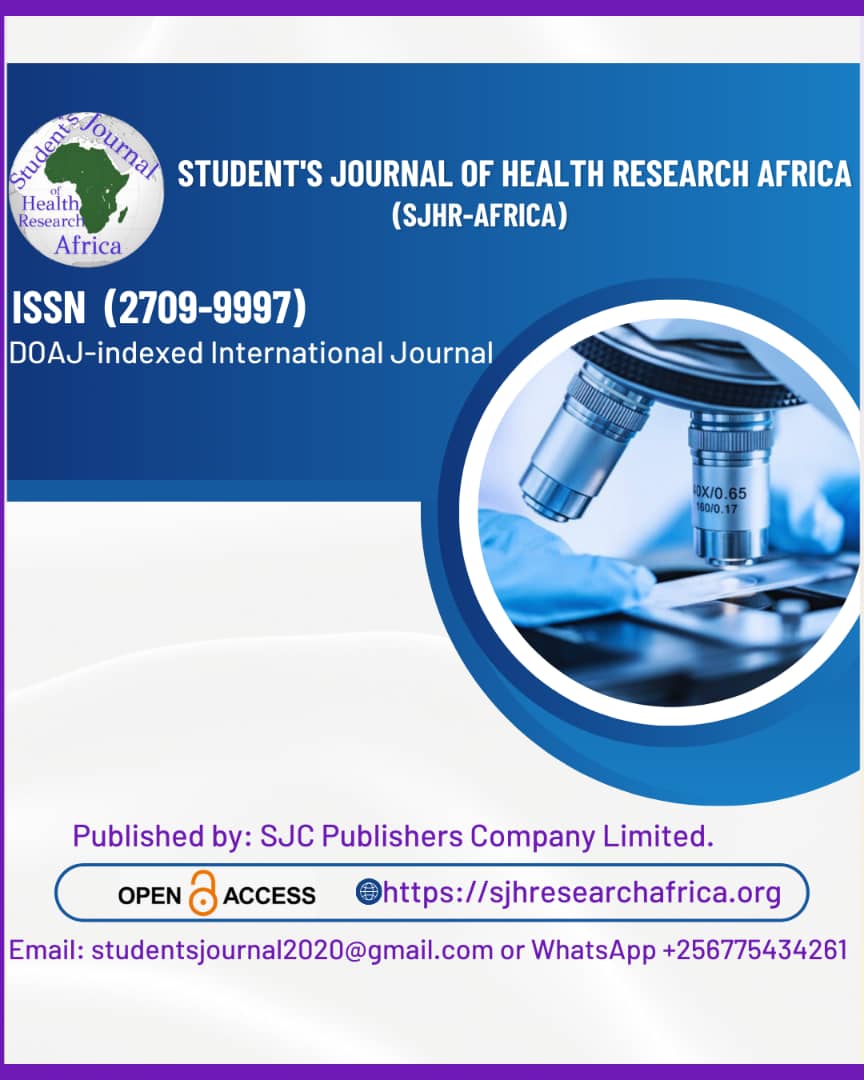PREFERRED PRACTICE OF CATARACT SURGERY IN BROWN CATARACT: A QUESTIONNAIRE-BASED SURVEY
DOI:
https://doi.org/10.51168/sjhrafrica.v5i11.1747Keywords:
Brown cataract, MSICS, phacoemulsification, extracapsular cataract extraction, trypan blue, questionnaire survey, preferred practice patternAbstract
Background
Brown cataracts, also called brunescent or hypermature cataracts, are difficult to operate on due to their thick nuclear sclerosis, capsular issues, and poor visualization. Ophthalmic surgeons debate the best surgical method for these cases based on their training, experience, and resources. Understanding preferred surgical methods may improve uniformity and training protocols.
Objective: A structured questionnaire survey of ophthalmic surgeons' preferred brown cataract surgical methods, intraoperative approaches, and postoperative management protocols.
Methods
A 20-item standardized questionnaire was given to 12 ophthalmic surgeons, 6 consultants, and 6 postgraduate trainees. Demographics preferred surgical methods (phacoemulsification, MSICS, ECCE), nucleus disassembly techniques, capsular dyes and viscoelastics, perceived complication rates, and IOL implantation methods were collected in the survey.
Results
58% of 12 respondents preferred MSICS for brown cataracts due to better nucleus extraction control and lower endothelial trauma risk. 33% chose phacoemulsification, mostly consultants with advanced experience and modern equipment. ECCE was used by 9% in resource-limited settings. 83% of surgeons routinely stained the anterior capsule with trypan blue, while 67% preferred dispersive viscoelastics to protect the corneal endothelium. The most common complication was posterior capsular rupture (25%), followed by zonular dialysis (16.7%). 50% used rigid PMMA lenses, but 42% preferred foldable lenses when available. Postoperative visual outcomes were satisfactory for 92% of respondents.
Conclusion
Ocular surgeons treating brown cataracts tend to use MSICS due to its safety, cost-effectiveness, and suitability for advanced nuclear sclerosis. Phacoemulsification is becoming more popular, but resource availability and the learning curve limit its use. Trypan blue and viscoelastics are widely used, indicating good surgical planning to reduce issues. These findings emphasize the need for MSICS and phacoemulsification training for complex cataracts and increased surgical adjunct availability in resource-limited settings.
References
Arshinoff, S. A. (2003). Dispersive-cohesive viscoelastic soft shell technique. Journal of Cataract & Refractive Surgery, 29(4), 646-652. https://doi.org/10.1016/S0886-3350(02)01617-9
Brien Holden Vision Institute. (2016). Global Vision Impairment and Blindness Study. Retrieved from https://www.brienholdenvision.org
Chang, D. F. (2004). Prospective surgical experience with capsular dye to facilitate cataract surgery in the mature cataract. Journal of Cataract & Refractive Surgery, 30(3), 662-665. https://doi.org/10.1016/j.jcrs.2003.07.010 PMid:14709287
Flaxman, S. R., Bourne, R. R. A., Resnikoff, S., et al. (2017). Global causes of blindness and distance vision impairment 1990-2020: a systematic review and meta-analysis. The Lancet Global Health, 5(12), e1221-e1234. https://doi.org/10.1016/S2214-109X(17)30393-5 PMid:29032195
Gimbel, H. V., Sun, R., & DeBroff, B. M. (2005). Use of trypan blue stain to visualize the anterior capsule during cataract surgery. Journal of Cataract & Refractive Surgery, 31(3), 419-424. https://doi.org/10.1016/j.jcrs.2004.08.038
Gogate, P., Deshpande, M., & Wormald, R. (2003). Is manual small-incision cataract surgery affordable in developing countries? A cost comparison with extracapsular cataract extraction. British Journal of Ophthalmology, 87(8), 843-846. https://doi.org/10.1136/bjo.87.8.843 PMid:12812880 PMCid:PMC1771751
Gogate, P., Deshpande, M., Nirmalan, P. K. (2007). Why do phacoemulsification? Manual small-incision cataract surgery is almost as effective, but less expensive. Ophthalmology, 114(5), 965-968. https://doi.org/10.1016/j.ophtha.2006.08.036 PMid:17174399
Melles, G. R. J., de Waard, P. W., Pameyer, J. H., & Houdijn Beekhuis, W. (1999). Trypan blue capsule staining to visualize the anterior capsule during cataract surgery. Journal of Cataract & Refractive Surgery, 25(1), 7-9. https://doi.org/10.1016/S0886-3350(98)80174-2 PMid:9888070
Nagpal, N., Arora, S., & Sood, A. (2001). Phacoemulsification in brunescent and black cataracts. Journal of Cataract & Refractive Surgery, 27(8), 1190-1191. https://doi.org/10.1016/S0886-3350(01)00714-7
Olson, R. J., Braga-Mele, R., Chen, S. H., Miller, K. M., Pineda, R., Tweeten, J. P., & Musch, D. C. (2011). Cataract in the adult eye preferred practice pattern. Ophthalmology, 118(2), 171-179. https://doi.org/10.1016/j.ophtha.2010.11.018 PMid:21459229
Rao, S. K., Lam, D. S. C., & Fan, D. S. P. (2012). Phacoemulsification in brown cataracts: challenges and surgical techniques. Asia-Pacific Journal of Ophthalmology, 1(5), 296-300. https://doi.org/10.1097/APO.0b013e31826bfc4f
Ruit, S., Tabin, G., Chang, D., Bajracharya, L., Kline, D. C., & Shrestha, S. K. (2007). A prospective randomized clinical trial of phacoemulsification vs manual small-incision cataract surgery in Nepal. American Journal of Ophthalmology, 143(1), 32-38. https://doi.org/10.1016/j.ajo.2006.09.021 PMid:17258535
Schlötzer-Schrehardt, U., & Naumann, G. O. H. (2006). Ocular and systemic pseudoexfoliation syndrome. American Journal of Ophthalmology, 141(5), 921-937. https://doi.org/10.1016/j.ajo.2006.01.047 PMid:16678509
Sharma, V. K., Agarwal, A., & Bhargava, N. (2015). Comparative study of phacoemulsification versus MSICS in brown cataract. Indian Journal of Clinical and Experimental Ophthalmology, 1(1), 1-6.
Thulasiraj, R. D., Dhivya, A., & Kumar, R. (2016). Community outreach and manual small incision cataract surgery in India. Community Eye Health Journal, 29(95), 36-37.
Vasavada, A. R., Raj, S. M., & Praveen, M. R. (2001). Phacoemulsification in eyes with hard cataract: Comparative clinical study. Journal of Cataract & Refractive Surgery, 27(12), 1797-1804. https://doi.org/10.1016/S0886-3350(01)01178-7
Venkatesh, R., Muralikrishnan, R., Balent, L. C., Prakash, S. K., & Prajna, N. V. (2005). Outcomes of high-volume cataract surgeries in a developing country. British Journal of Ophthalmology, 89(9), 1079-1083. https://doi.org/10.1136/bjo.2004.058537 PMid:16113352 PMCid:PMC1772816
World Health Organization (WHO). (2019). World Report on Vision. https://www.who.int/publications/i/item/world-report-on-vision
Downloads
Published
How to Cite
Issue
Section
License
Copyright (c) 2024 Govind Kumar Mandal, Pummy Roy, Jagdish Choudhary

This work is licensed under a Creative Commons Attribution-NonCommercial-NoDerivatives 4.0 International License.






















